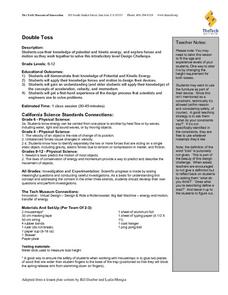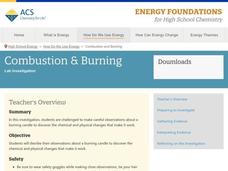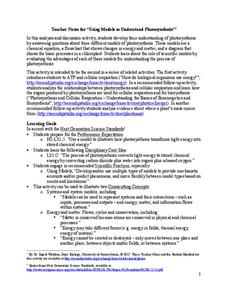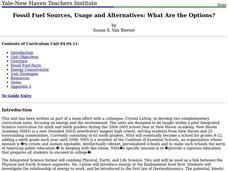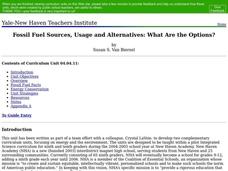Curated OER
Double Toss
Students experiment with potential and kinetic energy. They design a device that will toss a ball at least 30 centimeters, catch it and to the ball up again.
Curated OER
Tree House Escape!
Students participate in a role play in which they use simple machines to do the work of retrieving their sibling from a tree which lost its ladder. They investigate how work is accomplished when an object moves in the direction of the...
Royal Society of Chemistry
The 400m Event—Chemistry and Sport
How do Olympic runners succeed in physically demanding events like the 400-meter dash? Physiology scholars explore the relationship between acids, bases, and the muscular system through a scenario-driven activity. The lesson focuses on...
Teach Engineering
Investigating the Properties of Plastic and its Effects on the Environment
Pore over the properties of plastic. Working through four different stations, pupils investigate some properties of plastic, including chemical decomposition, mechanical breakdown, density, and the ability to infiltrate the food chain....
Curated OER
Chemical Energy
In this science worksheet, students read about enzymes and nutrition. Students also answer 2 comprehension questions about the reading.
CK-12 Foundation
Roller Coaster
Roller coasters rely on both kinetic and potential energy, but how much total energy does a roller coaster need? Scholars vary the mass of a coaster and the height of the initial hill. Graphs showing the types of energy and total energy...
CK-12 Foundation
Power and Efficiency Simulation
How much energy in Jewels does it take to tow a car up a slope? Scholars explore different values of both kinetic and potential energy to answer that question. Through multiple levels, the difficulty increases — as does your young...
CK-12 Foundation
Ballistics Tests
How did scientists measure the speed of incredibly fast things before the invention of high-speed photography? Scholars virtually perform ballistics tests to discover the process. They control the rifle type, bullet mass, and target...
American Chemical Society
Combustion and Burning
On Earth, a candle flame points up, but on the International Space Station, it forms a sphere. Young scientists practice their skills by recording observations before, during, and after a candle burns. Chemical and physical changes...
Urbana School District
Thermodynamics
Entropy, it isn't what it used to be. Presentation includes kinetic-molecular theory, heat and internal energy, thermal equilibrium, temperature scales, laws of thermodynamics, entropy, latent heat of fusion, specific heat, calorimetry,...
Curated OER
Lemon Batteries Revised
Fifth graders investigate how chemical energy in food and batteries is potential or stored energy. They discuss how batteries function, and create a class list of different forms of energy. Students then create a lemon battery that...
Cornell University
Isotope Rummy
Thanks to this game, teaching isotopes will never be the same. Physical science scholars work their way toward understanding isotopes in an entertaining game. Pupils play rummy in groups while practicing good sportsmanship and creating...
Curated OER
Backpacks and Hills
This machines PowerPoint reviews effort and force in relation to work and informs students about different types of machines and the different ways forces are applied and how they work to increase efficiency.
Curated OER
Las Maquinas y Nosotros: Machines and Us
Second graders explain the relationship between energy and work. In this technology lesson plan, 2nd graders describe the different uses of machines in their everyday lives. They record observations and data in their science journal.
Curated OER
Kaleidoscope
Students explore energy by creating a light project in class. In this kaleidoscope lesson, students discuss the properties of light and how mirrors can reflect the energy in different directions. Students view a diagram of light...
Serendip
Using Models to Understand Photosynthesis
Is your class in the dark about photosynthesis? Shed some sunlight on an important biological process with a thoughtful activity. After answering questions to help determine their level of knowledge, learners work with chemical equations...
Curated OER
Alternative Energy
Students identify the five major alternative energy sources. In this physical science instructional activity, students assess the advantages and disadvantages for each type of energy. They complete a concept map using information they...
Curated OER
Potato Launcher Energy Lab
Students investigate conservation laws using a potato launcher. In this physics lesson, students measure angles, time and distance of the potato. They discuss applications of experiments like this.
Curated OER
Worksheet 22
In this math worksheet, learners apply the following: In physics, the equation W=Fd gives the amount W of energy expended in moving a distance d by applying a constant force F.
Curated OER
Work and Power Crossword Puzzle
In this work and power worksheet, students complete a crossword puzzle containing 12 vocabulary terms related to work and power.
Curated OER
Work and Power Crossword Puzzle Answers
In this work an power learning exercise, students are provided with the answers to the 12 crossword clues about vocabulary pertaining to work and power.
Curated OER
Fossil Fuel Sources, Usage and Alternatives: What are the Options?
Young scholars identify the different sources of fossil fuels. In this environmental science lesson, students research about how these impact our environment. They explore renewable energy sources that could replace fossil fuels.
Curated OER
Fossil Fuel Sources, Usage and Alternatives: What Are the Options?
Young scholars examine the relationship between energy and the environment. In groups, they participate in experiments to discover the law of thermodynamics and the differences between potential, kinetic and mechanical forms of energy. ...
Curated OER
Applied Science - Physics Lab
Students investigate electricity. In this Physics lesson, students experiment with insulators and conductors of electricity. Students use batteries as the energy source for the experiment.


